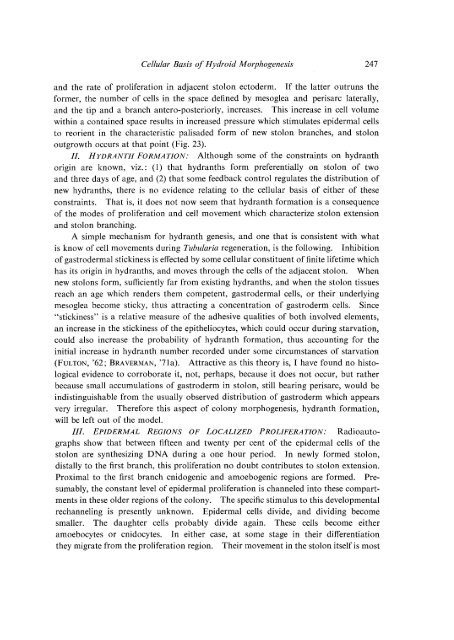THE CELLULAR BASIS OF HYDROID MORPHOGENESIS
THE CELLULAR BASIS OF HYDROID MORPHOGENESIS
THE CELLULAR BASIS OF HYDROID MORPHOGENESIS
You also want an ePaper? Increase the reach of your titles
YUMPU automatically turns print PDFs into web optimized ePapers that Google loves.
Cellular Basis of Hydroid Morphogenesis 247<br />
and the rate of proliferation in adjacent stolon ectoderm. If the latter outruns the<br />
former, the number of cells in the space defined by mesoglea and perisarc laterally,<br />
and the tip and a branch antero-posteriorly, increases. This increase in cell volume<br />
within a contained space results in increased pressure which stimulates epidermal cells<br />
to reorient in the characteristic palisaded form of new stolon branches, and stolon<br />
outgrowth occurs at that point (Fig. 23).<br />
II. HYDRANTH FORMATION: Although some of the constraints on hydranth<br />
origin are known, viz.: (1) that hydranths form preferentially on stolon of two<br />
and three days of age, and (2) that some feedback control regulates the distribution of<br />
new hydranths, there is no evidence relating to the cellular basis of either of these<br />
constraints. That is, it does not now seem that hydranth formation is a consequence<br />
of the modes of proliferation and cell movement which characterize stolon extension<br />
and stolon branching.<br />
A simple mechanism for hydranth genesis, and one that is consistent with what<br />
is know of cell movements during Tubularia regeneration, is the following. Inhibition<br />
of gastrodermal stickiness is effected by some cellular constituent of finite lifetime which<br />
has its origin in hydranths, and moves through the cells of the adjacent stolon. When<br />
new stolons form, sufficiently far from existing hydranths, and when the stolon tissues<br />
reach an age which renders them competent, gastrodermal cells, or their underlying<br />
mesoglea become sticky, thus attracting a concentration of gastroderm cells. Since<br />
"stickiness" is a relative measure of the adhesive qualities of both involved elements,<br />
an increase in the stickiness of the epitheliocytes, which could occur during starvation,<br />
could also increase the probability of hydranth formation, thus accounting for the<br />
initial increase in hydranth number recorded under some circumstances of starvation<br />
(FULTON, '62; BRAVERMAN, '7la). Attractive as this theory is, I have found no histological<br />
evidence to corroborate it, not, perhaps, because it does not occur, but rather<br />
because small accumulations of gastroderm in stolon, still bearing perisarc, would be<br />
indistinguishable from the usually observed distribution of gastroderm which appears<br />
very irregular. Therefore this aspect of colony morphogenesis, hydranth formation,<br />
will be left out of the model.<br />
Ill. EPIDERMAL REGIONS <strong>OF</strong> LOCALIZED PROLIFERATION: Radioautographs<br />
show that between fifteen and twenty per cent of the epidermal cells of the<br />
stolon are synthesizing DNA during a one hour period. In newly formed stolon,<br />
distally to the first branch, this proliferation no doubt contributes to stolon extension.<br />
Proximal to the first branch cnidogenic and amoebogenic regions are formed. Presumably,<br />
the constant level of epidermal proliferation is channeled into these compartments<br />
in these older regions of the colony. The specific stimulus to this developmental<br />
rechanneling is presently unknown. Epidermal cells divide, and dividing become<br />
smaller. The daughter cells probably divide again. These cells become either<br />
amoebocytes or cnidocytes. In either case, at some stage in their differentiation<br />
they migrate from the proliferation region. Their movement in the stolon itself is most

















